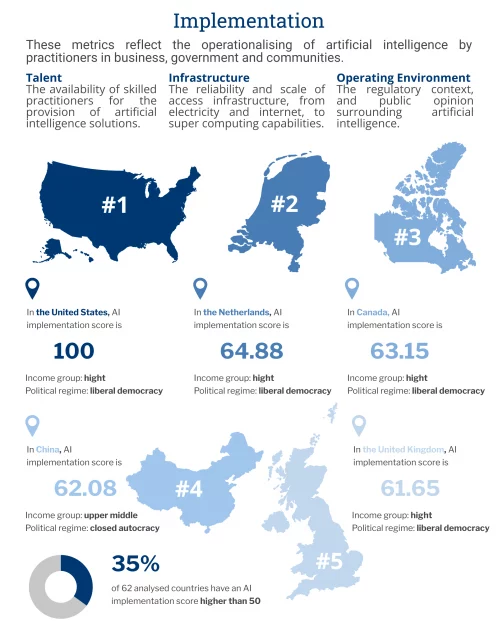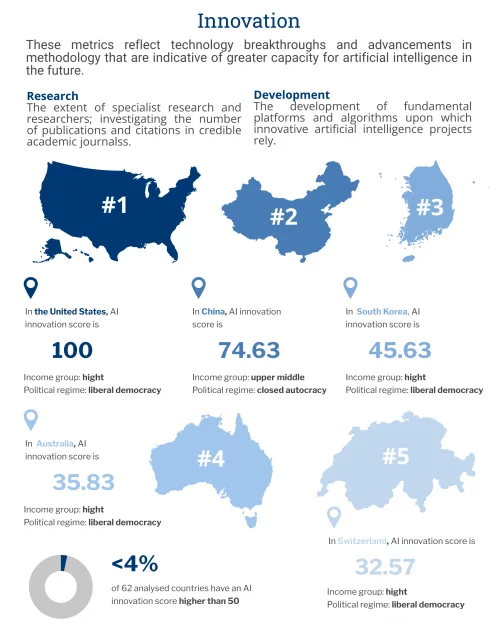Artificial Intelligence (AI) has become a global AI race and a key driver of economic growth as its evolution and implications are significant to various industries, making it a topic that demands attention. In light of the evolution of AI, it is essential to understand which countries are at the forefront of AI progress — to ensure economic competitiveness, national security, and responsible technological advancement.
Tortoise Media is providing the data for making sense of AI globally. They are considering 143 indicators split into seven groups, comprising three AI analysis pillars: implementation, innovation, and investment. The data on each group is available for 62 countries and used for the following analysis in this article.
Implementation
Implementation metrics represent the application of artificial intelligence by professionals in various sectors, such as businesses, governments, and communities. The implementation factors group may be divided into three smaller groups - Talent, Infrastructure, and Operating Environment.
Americans Are Most Talented in AI
The talent factors group emphasizes the presence of proficient experts who can deliver artificial intelligence solutions. They include the absolute and relative numbers of AI engineers, Data Scientists, and Machine engineers, commits related to AI on GitHub, Kaggle ‘grandmasters’ and IT graduates, etc.
According to the provided dataset, the United States is the top country in the number of AI talents (an average score of all factors is 100). The following country with the lower score is India (a score of 45,3). The other three countries in the top-5 countries with skilled practitioners in AI are Great Britain, Singapore, and Israel, with almost equal scores (~40). The law scores of leaders and score median of 13.45 demonstrate an unfavorable state of the AI experts market for most countries.
China’s Infrastructure Is Most Appropriate for AI
Infrastructure factors focus on the dependability and scalability of the access infrastructure, ranging from electricity and internet to supercomputing capabilities. These factors include the ratio of the total population with access to electricity, the internet, the level of 5G implementation, etc.
As data say, China is better prepared for AI technologically (a score is 100). Hong Kong, Luxemburg, and the United States are just a little behind, with scores higher than 90. Ireland ends the top-5 rating with a score of 89.5. 80% of the analyzed countries have an Infrastructure indicators score higher than 50, while just one country has a total score of the Talent group indicators higher than 50. It illustrates the high global level of infrastructural capacity in comparison with the deficit of AI specialists.
Saudi Arabia's Society Is Most Friendly to AI
The Operating Environment group of factors concentrates on the regulatory environment and the public perception of artificial intelligence. The group consists of such factors as the level of data privacy legislation, gender diversity of AI professionals, the share of people who trust AI, etc.
Generally, the world society is optimistic about AI (85% of the analyzed countries have an Operating Environment group score higher than 50); the five most benevolent countries are Saudi Arabia (a score is 100), Poland, Mexico, Slovenia, and Canada.
Under weights for each indicator group, justified by Tortoise Media in their methodology report, the top-5 countries with the highest AI implementation level are the United States, The Netherlands, Canada, China, and Great Britain. Only 35% of analyzed countries have an implementation score higher than 50.

Innovation
Innovation metrics reflect the progress made in technology and methodology, which signify the potential for artificial intelligence to evolve and improve. According to Tortoise Media, the innovation metrics are divided into two smaller groups — Research and Development.
US Specialists Are Generating More AI Ideas
The Research indicator analyzes the degree of specialization among researchers and their research activities, specifically focusing on quantifying the number of publications and citations in reputable scholarly journals. This complex indicator accounts for total spending on research and development, the absolute and relative number of AI-related articles, researchers, and universities with AI-related courses.
The global state of the AI Research indicator is unpleasant — only two countries have scored higher than 50, one of which is the United States (a score is 100). It’s not surprising since we have already found that the country has the most specialists related to AI. The second country is China (a score of 71,4); it has been investing heavily in AI and technology education in recent years to become a global leader in the AI sphere. The following three countries on the top-5 list are Switzerland, Singapore, and the United Kingdom.
AI Development in the USA Is at the Highest Level
The group of Development indicators focuses on fundamental platforms and algorithms development upon which innovative artificial intelligence projects rely. It includes the absolute and relative number of software developers who are core creators of open-source "AI packages," the number of commits to "open-source AI packages," the number of patents relating to "AI," etc.
Globally, only three countries are on a high level of development in the AI field; they are the USA (a score is 100), China (a score is 80), and South Korea (a score is 77,3). The score of other countries is lower than 50. To complete the top-5 list, - the last two countries are Australia and Japan.
Thus, the top-5 countries with the highest level of innovation in AI are the United States, China, South Korea, Australia, and Switzerland. However, only the first two have an innovation score higher than 50. It testifies to the low level of AI development among the countries (in comparison with the leader - the USA) despite the shreds of evidence of AI worldwide exponential growth.

Investment
Investment metrics reflect financial and procedural commitments to artificial intelligence. Tortoise Media divides these metrics into two groups of indexes - Government Strategy and Commercial.
The Canadian Government Is the Most Inclined Toward the AI Growth
The Government Strategy indicator focuses on the extent of national commitment to artificial intelligence by examining both spending allocations and national-level plans. It factors in the amount of dedicated investment in AI by the government, the level of tax credit for research and development, dedicated spending on AI, etc.
Almost 70% of the countries in our sample are ready for AI evolution at the governmental level; their Government Strategy indicator score is higher than 50. The first five countries in the rate are Canada, China, Saudi Arabia, Spain, and France (it is 5 out of 6 countries with a score higher than 90).
The United States Is an Absolute Leader in the AI Commercialisation
Commercial indicators evaluate the degree of startup engagement, investment, and business ventures that rely on artificial intelligence. These indicators include the absolute and relative numbers of AI companies and startups, their total and average funding, etc.
The United States is leading in the commercialization of AI and has no direct competition in this field. China is the closest country to the USA but is 66% behind. The three following countries are Israel, the United Kingdom, and Singapore; their commercial scores are lower than 30.
Although the United States Government Strategy in AI is not even in the top-5 of the strongest ones, it is scoring high on Investment indicators and is ranking first. The following four countries are China, Israel, the United Kingdom, and Canada; their Investment level is far behind the USA.

The Global AI Index
The Global AI Index (GAII) is an indicator created by Tortoise Media to rank countries based on the capacity for AI, specifically by measuring investment, innovation, and implementation levels. According to the previous and current values of the GAII, Tortoise Media divides countries into five clusters - power players, traditional champions, rising stars, waking-up players, and nascent players.
According to the GAII measured by Tortoise Media, two power players are on the map - the United States and China; however, China is almost 40% weaker than the USA. The following two countries, the United Kingdom and Canada are traditional champions (according to Tortoise Media’s classification).
However, Germany and France are the other two traditional champions, standing in four positions after Israel, Singapore, South Korea, and the Netherlands, classified as rising stars. The other rising stars are Australia, Irlandia, Finlandia, Denmark, Japan, and Spain. All the other countries (among the analyzed 62 countries) except Sri Lanka, Egypt, Kenia, Nigeria, and Pakistan are the waking-up players; the last are nascent AI market players.

Conclusions
Despite being a broadly defined and enigmatic field, artificial intelligence continues to be a topic of extensive public debate, media frenzy, and political disagreement. Many countries are now hastening the publication of their national strategies for artificial intelligence, with a view to either revising or updating the approaches they adopted in previous years.
The analysis demonstrates that de jure, the majority of countries are favorable to AI growth - AI infrastructure is at a high level, and government and operating environment are supportive of AI. However, the de facto situation differs - there is not enough AI talent and, as a result, not enough innovations and development for many countries; there is a deficit of investments and under-commercialization in the AI sphere.
The United States and China demonstrate the best technical, financial, and social environment for AI growth, although the USA is far ahead. While these countries do not face stiff competition from other countries, many countries still have huge potential in the AI field.
Talking about the prospects, AI is expected to continue to grow globally. In recent years, there has been a significant increase in investment, research, and development in AI, with many countries considering it a strategic priority.
AI has already demonstrated its potential to transform various sectors, including healthcare, finance, transportation, and education. With the ongoing advancements in AI technologies such as deep learning, reinforcement learning, and natural language processing, among others, the potential applications of AI are vast and ever-expanding. Therefore, it is likely that AI will continue to grow and have a significant impact on many aspects of our lives in the future.







